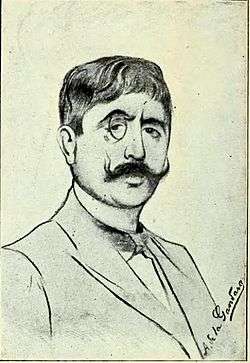Jean Moréas

| French literature |
|---|
| by category |
| French literary history |
| French writers |
|
| Portals |
|
Jean Moréas (French: [mɔreas]; born Ioannis A. Papadiamantopoulos, Ιωάννης Α. Παπαδιαμαντόπουλος; 15 April 1856 – 31 March 1910[1]), was a Greek poet, essayist, and art critic,[2] who wrote mostly in the French language but also in Greek during his youth.[3]
Biography
Moréas was born into a distinguished Athenian family on April 15, 1856.[1] His ancestors included two well-known men of the Greek War of Independence, namely his paternal grandfather and namesake Ioannis Papadiamantopoulos (1766–1826), born in Corinth but of ultimately Epirote ancestry[4] (he was executed after the fall of Missolonghi),[5] and his maternal granduncle Iakovos Tombazis (c. 1782–1829),[6] from Hydra, who became one of the first admirals of the Greek navy.[7] Moreas's father was Adamantios Papadiamantopoulos, a judge, scholar, and poet.[8] Moreas received a French education, and went to Paris in 1875 to study law at the University of Paris. While in France, he began associating with literary circles, and became acquainted with Les Hydropathes, a group of French writers that included Alphonse Allais, Charles Cros, Guy de Maupassant, and Léon Bloy. He was also an acquaintance of the Greek artist Demetrios Galanis and the Romanian poet Ion Minulescu.
Moréas died in Paris, France on March 31, 1910.[1]
Works
Moréas published poetry in his publications Lutèce and Le Chat noir, and collected his poems into two editions, Les Syrtes ("The Sandbanks") and Cantilènes, which were strongly influenced by Paul Verlaine.
He was initially a practitioner of the style of Symbolism, and wrote the Symbolist Manifesto (1886), which he published in the newspaper Le Figaro, partly to redeem the reputation of the new generation of young writers from the charge of "decadence" that the press had implied. He was considered one of the most important Symbolist poets until the early 1890s.
In 1891, as Symbolism became more openly associated with anarchism, he published Le Pèlerin passionné which rejected Northern European and Germanic influences, such as Romanticism (as well as some aspects of Symbolism), in favor of Ancient Roman and Ancient Greek influences. This work helped initiate the École Romane, the aesthetic of which provided Charles Maurras with the ideology necessary for the far-right philosophy Action Française.
Moréas also wrote Les Demoiselles Goubert, a novel, in association with Paul Adam. His most important publications were:
- Les Syrtes (1884)
- Les Cantilènes (1886)
- Le Pèlerin passionné (1891)
- Stances (1893)
- Contes de la vielle France (1904)
References
Citations
- 1 2 3 "Jean Moréas". Encyclopaedia Britannica. Encyclopaedia Britannica, Inc. 14 August 2007. Retrieved 30 November 2016.
- ↑ Butler 1967, p. 176; Rees 1992, p. 388; Shipley 1972, p. 235.
- ↑ Τρυγόνες καί Έχιδνες – Vipers and Turtledoves (1873).
- ↑ Jouanny 1975, Chapter II: "Histoire d' une Famille", pp. 51–53.
- ↑ Finlay 1861, p. 111.
- ↑ Jouanny 1975, Chapter II: "Histoire d'une Famille", p. 60.
- ↑ Raynaud 1929, "Jean Moreas: L' Homme: sa vie intime", pp. 11–12.
- ↑ Adamson 2007, p. 70; Rees 1992, p. 388; Tiryakian 2009, p. 157; Hammerton 1975, p. 1011.
Sources
- Adamson, Walter L. (2007). Embattled Avant-gardes: Modernism's Resistance to Commodity Culture in Europe. Berkeley and Los Angeles, California: University of California Press. ISBN 978-0-520-25270-7.
- Butler, John Davis (1967). Jean Moreas: A Critique of His Poetry and Philosophy. The Hague, Netherlands and Paris, France: Mouton.
- Finlay, George (1861). History of the Greek Revolution (Volume II). London and Edinburgh, United Kingdom: William Blackwood and Sons.
- Hammerton, Sir John Alexander (1975). Concise Universal Biography: A Dictionary of the Famous Men and Women of All Countries and All Times, Recording the Lives of More Than 20,000 Persons and Profusely Illustrated with Authentic Portraits and Other Pictorial Documents. Detroit, Michigan: Gale Research Company. ISBN 978-0-8103-4209-5.
- Jouanny, Robert A. (1975). Jean Moréas, écrivain Grec (Bibliothèque des lettres modernes, Volume 25) (in French). Paris, France: Lettres Modernes Minard. ISBN 2-256-90750-3.
- Raynaud, Ernest (1929). Jean Moréas et les Stances: avec un index de tous les noms cités. Paris, France: Société Française d'Éditions Littéraires et Techniques.
- Rees, William (1992). The Penguin Book of French Poetry 1820-1950: With Prose Translations. London, United Kingdom: Penguin Classics. ISBN 978-0-14-042385-3.
- Shipley, Joseph Twadell (1972). Modern French Poetry: An Anthology. Manchester, New Hampshire: Ayer Publishing. ISBN 0-8369-6394-6.
- Tiryakian, Edward A. (2009). For Durkheim: Essays in Historical and Cultural Sociology. Burlington, Vermont: Ashgate Publishing Company. ISBN 978-0-7546-7155-8.
Further reading
- Andreas Embirikos. Les étapes de Jean Moréas. Lausanne, 1948.
- R. Georgin. Jean Moréas. Paris, 1930.
- Jean de Gourmont. Jean Moréas. Paris, 1905.
- J. Weber. Jean Moréas u. die französische Tradition. Nuremberg, 1934.
External links
 French Wikisource has original text related to this article: Jean Moréas
French Wikisource has original text related to this article: Jean Moréas Greek Wikisource has original text related to this article: Ζαν Μορεάς
Greek Wikisource has original text related to this article: Ζαν Μορεάς- (French) Moréas' Poems